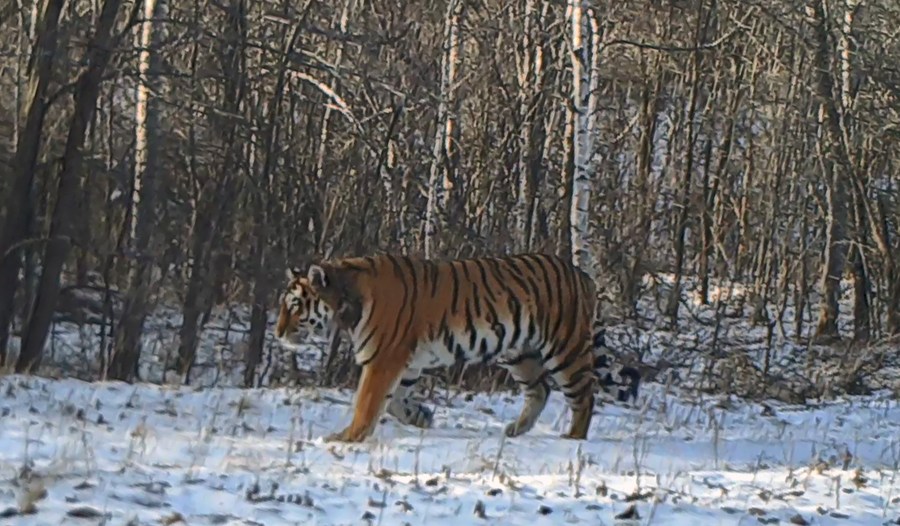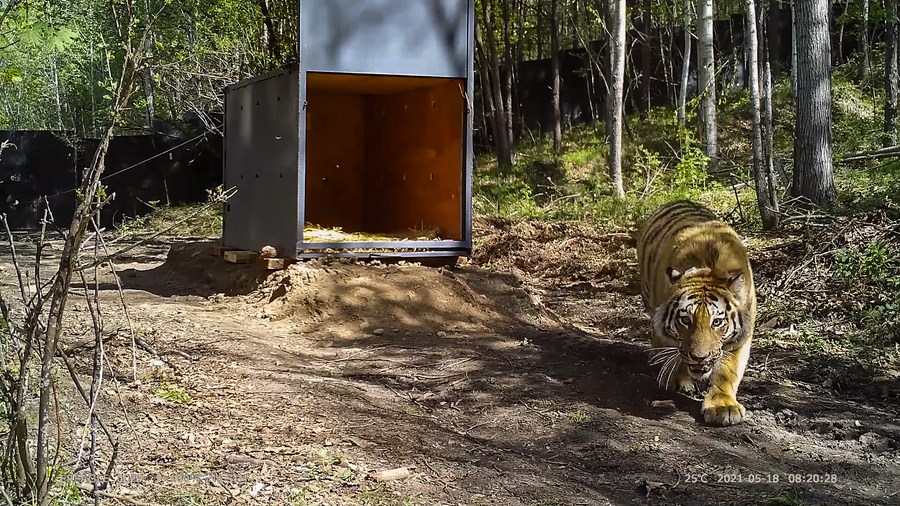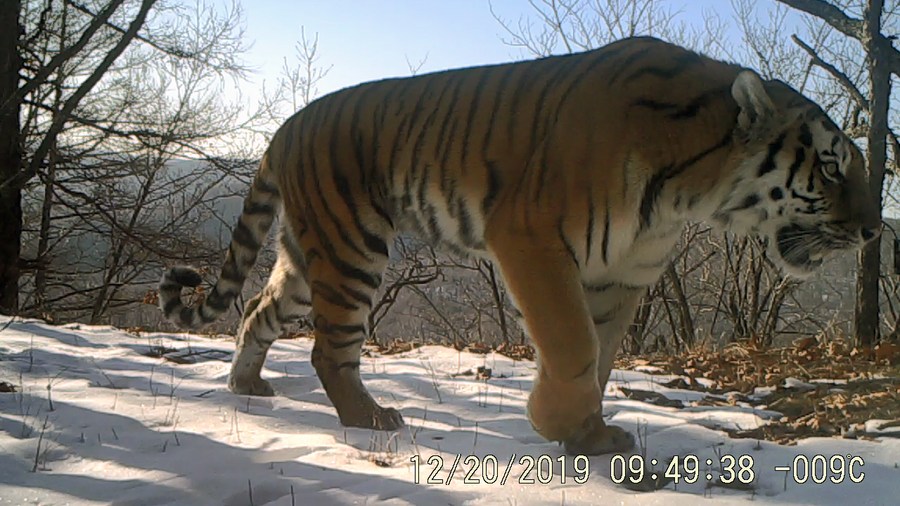-- Northeast China has reported more sightings of Siberian tigers in recent years. Conservationists and wildlife officials have interpreted this as a sign of a growing population and expanded territories of the endangered big cat.
-- On April 23, a wild tiger strayed into a village in Heilongjiang, injuring a local resident. Wildlife authorities captured it and released it into another safe spot on Tuesday. This is the first time that China has rescued a wild Siberian tiger and released it into its natural habitat.
-- In recent years, China has launched initiatives including afforestation, bans on commercial logging and detrapping operations to restore the felines' natural habitats.
-- The protection of the tigers also benefited from China's enhanced international cooperation, particularly with Russia, to build wildlife migration channels.

Undated photo taken by a far infrared camera shows a wild Siberian tiger at the Suiyang branch of the Northeast China Tiger and Leopard National Park management bureau in northeast China's Heilongjiang Province. (Xinhua)
by Xinhua Writers Yao Yuan, Li Baojie, Wang Chunyu, Sun Xiaoyu, Wang Song
HARBIN, May 21 (Xinhua) -- An improving eco-system in northeast China is adding to a cheerful yet stressful situation for conservationists: more wild Siberian tigers are showing up, sometimes even in human settlements.
Siberian tigers, also known as Amur or Manchurian tigers, were once elusive in the China-Russia border region, but this year they have been sighted multiple times in China's Heilongjiang and Jilin.
On April 23, a wild tiger strayed into a village in Heilongjiang, injuring a local resident. Wildlife authorities captured it, and after an evaluation that confirmed its health, released it into the wild on Tuesday.
This is the first time that China has rescued a wild Siberian tiger and released it into its natural habitat, officials said.
The animal's appearance in the city of Mishan outside its traditional habitat shows its population is growing and its territory expanding, said Zhou Shaochun, an expert on endangered wildlife at Heilongjiang Academy of Forestry.
"It was an important finding and something we conservationists and researchers have been anticipating avidly," said Zhang Minghai, an expert on wildlife and habitat protection at the Northeast Forestry University.
The city of Mishan lies in a cross-border corridor designed for Siberian tigers in China and Russia, Zhang said. Officials have expected the ecological corridor to link up tigers' segmented habitats and facilitate their migration and gene exchanges.
Prior to this direct tiger-human encounter, more evidence of tigers' habitat expansion had surfaced. Their footmarks were found in an artificial forest in the city of Mudanjiang, Heilongjiang, earlier this year. In November, a police officer spotted a wandering tiger when driving a car to patrol a tree farm in Jilin.
About 500 Siberian tigers, one of the world's most endangered species, are believed to be living in the wild. In 1988, some experts predicted the wild Siberian tigers, pushed to the brink of extinction due to lumbering and hunting, would disappear from China in four decades.

The video screenshot shows a wild Siberian tiger released back into the wild in northeast China's Heilongjiang Province on May 18, 2021. (Xinhua)
EXPANDED SAFE ZONE
In recent years, government initiatives including afforestation, bans on commercial logging and detrapping operations have helped restore the felines' natural habitats.
Satellite data showed in 2019, the vegetation quality in Heilongjiang was 27 percent higher than that in 2000, and the best in the past two decades. Between 2016 and 2020, the province completed afforestation on 388,000 hectares of land to raise its forest coverage rate to 47.3 percent.
China is also piloting the Northeast China Tiger and Leopard National Park as a sanctuary for Siberian tigers and Amur leopards. Spanning 1.46 million hectares in Jilin and Heilongjiang, the park is hailed as a "highland" for the highly endangered species.
Local authorities regularly send forest rangers to patrol the park and the neighboring area and clear traps set by poachers. With the improving environment, infrared cameras set up in the park have captured more of the big cats in recent years, indicating their rising population.

Aerial photo taken on May 19, 2021, shows a view of the pilot area of Suiyang branch of the Northeast China Tiger and Leopard National Park management bureau in northeast China's Heilongjiang Province. (Photo by Gu Jingkun/Xinhua)
"We have set up about 400 far infrared cameras on the mountain, and we collect and maintain data in May, July and October every year," said Guo Wenliang, a researcher with the Suiyang branch of the Northeast China Tiger and Leopard National Park management bureau.
The 40-year-old, who previously worked as a timber salesman for the bureau, switched to his current job after commercial logging was banned in major state forests in Heilongjiang in 2014.
The Suiyang branch administers 256,000 hectares under the national park. It is China's top-priority zone for the protection of Siberian tigers and Amur leopards, providing an important space for their free migration and breeding.
"The camera has captured pictures of Siberian tigers, sika deers and wild boars, showing that the wild animals are under better protection," said Guo with a big smile when checking a camera in the park.
According to the bureau, monitoring cameras in the Suiyang branch have captured Siberian tigers 190 times since October 2017, offering additional evidence of the species' growing population.

Photo taken by a far infrared camera on Dec. 20, 2019, shows a wild Siberian tiger at the Suiyang branch of the Northeast China Tiger and Leopard National Park management bureau in northeast China's Heilongjiang Province. (Xinhua)
CHINA-RUSSIA COOPERATION
The protection of the tigers also benefited from China's enhanced international cooperation, particularly with Russia, to build wildlife migration channels.
In 2020, a wild Siberian tiger and cub from Russia roamed into a nature reserve in Heilongjiang, where she stayed for about a month before returning to Russia. Around 100 Chinese and Russian tiger protection staff joined the tracking, research and protection of the family.
In June 2019, China and Russia signed a joint statement on developing a comprehensive strategic partnership of coordination for a new era that includes joint construction of an ecological corridor to ensure the free migration of Siberian tigers and Amur leopards on the Sino-Russian border.
Protection of wild Siberian tigers is a complex issue that demands transnational cooperation, said Jiang Guangshun, executive deputy director of the feline research center of the State Forestry and Grassland Administration.
While maintaining the good momentum, China and Russia should expand the cooperation depth and scope, and gradually form standardized and institutionalized cooperation and exchange channels, Jiang said.
(Video reporters: Wang Chunyu, Wang Song, Sun Xiaoyu. Video editor: Zhang Qiru) ■




